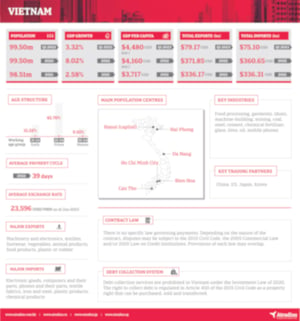

Trade in Asia - Vietnam
Insights
Vietnam: Turning Ambition into Reality
Despite a challenging year for most economies around the world, Vietnam’s economy grew its fastest in 25 years (at 8.02%) in 2022. The country is benefiting from a rare global supply chain pivot as international brands such as Apple and Samsung Electronics expand their manufacturing and research and development activities in the country. International ratings agencies have upgraded Vietnam’s long-term sovereign credit ratings, reflecting the country’s improved macro-economic fundamentals and resiliency. This bodes well for the Southeast Asian economy as it sets its sights on becoming a high-income country by 2045.
However, an uncertain global economy presents headwinds over the short term. Export demand is expected to slow over the next several months due to high inflation and interest rates in its major export markets.
Vietnam at a glance

State of the economy
Vietnam pulled off a resounding recovery in 2022, powered by exports, a rebound in retail and investments. Total exports rose 10.6% to US$371.85 billion and retail sales surged nearly 20%.
Foreign direct investments reached VND521.9 billion (US$22.13 billion) in 2022, largely going into the processing and manufacturing industry. From being mainly known for its labour-intensive industries such as garments and footwear manufacturing, the country’s manufacturing sector is increasingly producing more sophisticated products such as mobile phones and accessories..
Key to Vietnam’s attractiveness as a manufacturing and export hub is its membership in several major free trade agreements with key trading partners, including the Regional Comprehensive Economic Partnership (RCEP), EU-Vietnam Free Trade Agreement (EVFTA), and the Association of Southeast Asian Nations (ASEAN) agreements with China, Japan, India and South Korea, among others. Political stability and relatively lower production costs and land rents add to the country’s competitive advantage.
_________________________________
Vietnam’s inherent attributes – a geographically advantageous location giving it access to global shipping routes and proximity to China, and a young, upwardly mobile population providing a strong domestic consumption base – enhance its attractiveness as a destination for foreign direct investments over the long term.
_________________________________
Like other Asian economies, the country’s inflation rate picked up in 2022, but remained relatively subdued. While the central bank also tightened policy rates in line with global trends, the impact was blunted by the easing of the cap on credit growth. Meanwhile, the jobless rate remained low at 2.32%, with nearly 70% of the country’s 52 million-strong working age population employed.
%20(1).jpeg?width=719&height=405&name=Stock%20photo%203%20(2)%20(1).jpeg)
Challenges and risks
Like other export-driven economies, Vietnam’s outlook is closely tied to the global economy. Higher inflation and interest rates are expected to dampen global demand, particularly in the world’s largest economies. This could, in turn, reduce export orders and potentially put pressure on Vietnamese exporters’ bottom lines, with potential knock-on effects on the credit system through longer cash conversion for account receivables, nonperforming loans or defaults.
Vietnamese companies have stayed competitive in this challenging environment by offering longer credit periods than the usual 30-day average from invoicing as a way to reward customer loyalty. Trade on credit became a source of short-term funds for customers with temporary liquidity shortfalls, and was used to replace or supplement bank loans.
Open account trading is also becoming more prevalent as Vietnamese companies expanding abroad seek to remain competitive against their peers in the international market. As the payment window lengthens, so does the risk of nonpayment. Businesses without the ability to extend credit or withstand a potentially larger extent of loss may find their ambitions curtailed.
Pressure to offer more liberal payment terms to fuel growth while effectively managing the accompanying risks has created a strong need for strategic credit management to avoid liquidity problems. Such measures are especially pertinent as underdeveloped insolvency laws and new rules prohibiting debt collection mean businesses often elect to write off bad debt over going through the long and expensive debt recovery process.
Traditionally handled in-house, an increasing number of companies have opted for the benefits of credit insurance cover to manage risk on nonpayment and drive business growth. Trade credit insurers such as Atradius have established local networks to help companies protect against payment defaults and bad debts, as well as provide valuable risk information and market intelligence which remain difficult to obtain.
__________________________________
Moreover, companies doing business in Vietnam still face onerous
regulations and administrative procedures, weak intellectual
property protection and corporate governance, complex corporate
tax system, and infrastructure and digital connectivity gaps.
__________________________________
The government has recently introduced broad reforms to address these challenges, including modernising the tax system in line with global practices by 2030 and simplifying and reducing the cost of regulatory compliance by 20% between 2020 and 2025.
 While the manufacturing sector is poised to expand significantly in the coming years, Vietnam’s ability to fulfill increasing demand for manufactured goods may be hampered by its inadequate infrastructure, such as in transport connectivity and power. Current infrastructure spending still lags needed investments by around US$100 billion, according to the Global Infrastructure Outlook. However, approximately 2,000 kilometers of expressway are targeted to be completed between 2021 and 2025.
While the manufacturing sector is poised to expand significantly in the coming years, Vietnam’s ability to fulfill increasing demand for manufactured goods may be hampered by its inadequate infrastructure, such as in transport connectivity and power. Current infrastructure spending still lags needed investments by around US$100 billion, according to the Global Infrastructure Outlook. However, approximately 2,000 kilometers of expressway are targeted to be completed between 2021 and 2025.
Despite regulatory changes to the country’s fragmented banking sector, Vietnam’s four largest state-owned banks retain the capacity to control areas like nonperforming loans, capital injection, debt relief, and waiver of conditions to further support companies’ core businesses.
However, as traditional practices not to separate core and non-core assets hold strong, companies remain at risk of exposing their core businesses to liabilities from non-core investments, such as real-estate.
Economic outlook
The International Monetary Fund forecasts GDP growth to decelerate to 6.7% in 2023, but it still puts Vietnam among the fast-growing economies in Asia, and well within the government’s 6.5%-7% target for the period 2021-2025. Growth in agricultural exports is expected to be a bright spot for the economy.
As Vietnam braces for the impact of weak global demand seen to continue for the near future, its unique relationship with China is expected to help cushion the brunt, a distinct advantage other countries similarly exposed to export markets may not have. China’s post-COVID reopening is expected to boost Vietnam’s tourism industry and improve its trade balance with its second-largest export partner behind the US.
Monetary policy easing is one of the key tools that the government may employ in the coming months to bolster the domestic economy as a counter to falling external demand. Moreover, Vietnam’s healthy debt-to-GDP ratio suggests the government’s capacity for further spending.
As Vietnam bids to capitalise on structural changes in global trade and support GDP growth at the same time, it continues to invest in infrastructure development to ensure long-term growth sustainability. With more than half of the population at working age, a relatively low cost base, trade connectivity and political stability, Vietnam is a compelling new hub for global supply chains..jpeg?width=730&height=411&name=Stock%20photo%201%20(2).jpeg) As Vietnam’s economy matures, its service economy – currently the largest contributor to the country’s GDP – sees significant room for growth, fueled by its strong demographic advantage of a young and well-educated population. Vietnam’s digital economy is also expected to rapidly grow between 2022 and 2026, and will be the fastest by 2026 among the 51 countries surveyed in the FT-Omdia Digital Economies Index.
As Vietnam’s economy matures, its service economy – currently the largest contributor to the country’s GDP – sees significant room for growth, fueled by its strong demographic advantage of a young and well-educated population. Vietnam’s digital economy is also expected to rapidly grow between 2022 and 2026, and will be the fastest by 2026 among the 51 countries surveyed in the FT-Omdia Digital Economies Index.
The country’s remarkable track record of major transformation over the last 30 years – turning a war-scarred, closed economy into an open and globally competitive one – offers a positive precedent for its ability to achieve its high-income nation ambition in the next few decades.
For businesses with the patience to see the full blossoming of Vietnam’s economy, positioning today for coming opportunities will be key. Working with professional partners on the ground with extensive industry networks and in-depth knowledge of key business operations, including credit risk management, could offer advantages for early movers.
This article was produced with the help of insights from the following Atradius experts: Michael Frigo, Regional Director, Southeast Asia; Hanh Vu, Country Manager, Vietnam; Anh Ngo, Senior Risk Analyst, Vietnam
All content on this page is subject to our Disclaimer, available here.

